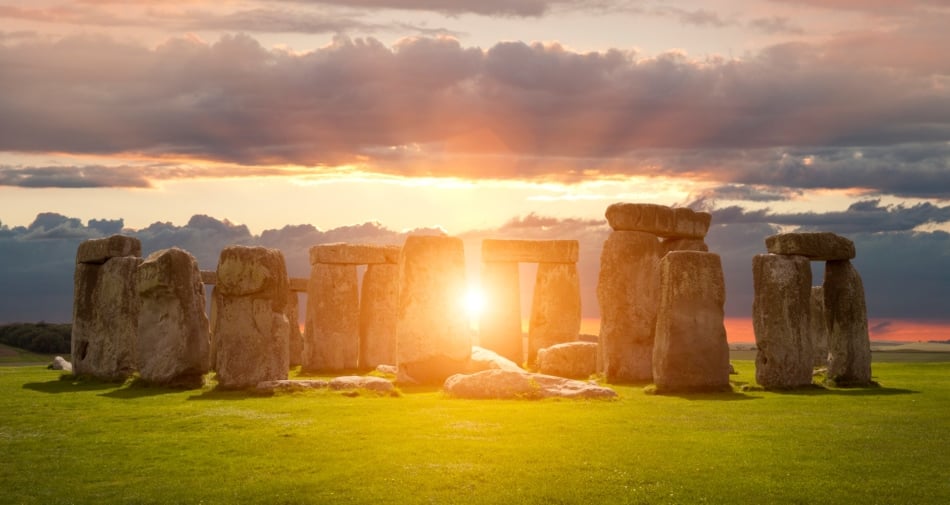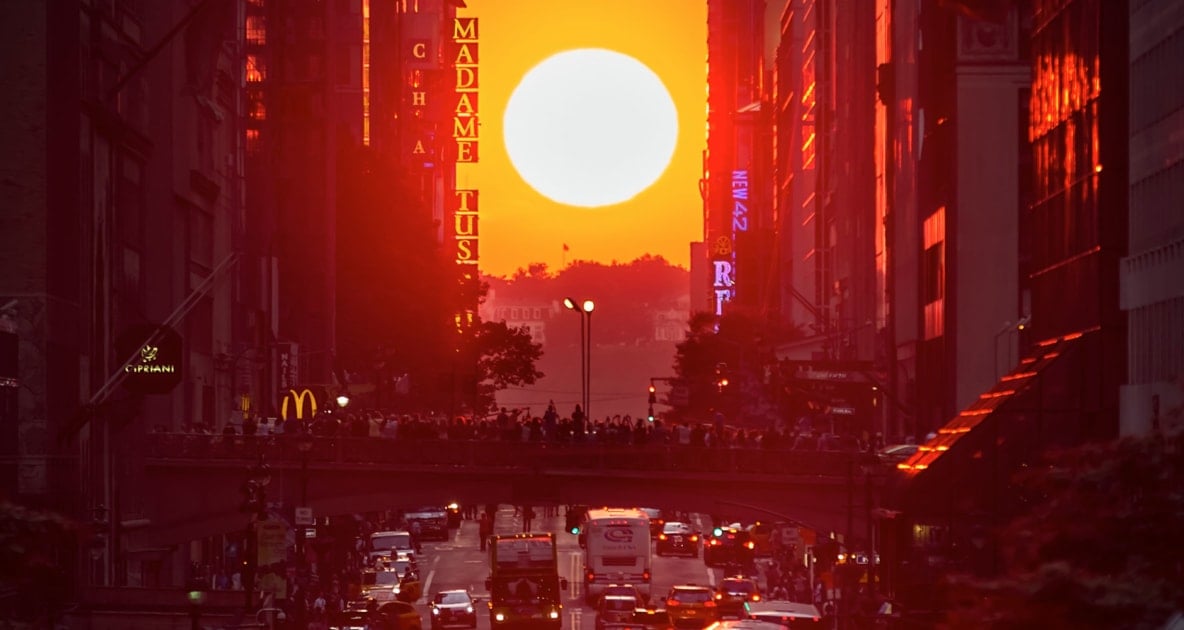“Manhattanhenge” (Manhattan henge), popularized by renowned astrophysicist Neil deGrasse Tyson of the American Museum of Natural History, refers to times when the Sun aligns with the streets in New York City (east-west) and becomes framed by skyscrapers as it sets. The term is a nod to Stonehenge, a prehistoric observatory in Wiltshire, England, which aligns with the rising Sun on the summer solstice. Learn more about this beautiful phenomenon, including dates for Manhattanhenge 2025.

Ironically, the term “henge” from the name Stonehenge has nothing to do with astronomy. It’s an ancient precursor to our word “hinge,” and refers to a place where two things join together. Stonehenge, then, means something like, “the place where all those stones are stacked together.”
RELATED: Chicago’s “Chicagohenge,” via Adler Planetarium
The use of “henge” for places where the Sun lines up with the surrounding architecture has since spread. Although Manhattanhenge is perhaps one of the most dramatic displays of the phenomenon, due to its location on the Atlantic seaboard, other communities built on grid plans boast their own “henges.” There’s Chicagohenge, Torontohenge, Montrealhenge, and even MIT-henge at the Massachusetts Institute of Technology (which may actually have preceded Manhattanhenge as the first modern usage of the term).
What Causes Manhattanhenge?
Most of Manhattan’s east-west streets are aligned at about a 29° angle clockwise from true east-west. So, twice each year, a couple of weeks before and a couple of weeks after the summer solstice, when the azimuth for sunset is 29° northward of due west, the setting Sun aligns with the east-west streets at the moment it sits on the horizon. This is known as Half Sun Manhattanhenge because half of the Sun is below the horizon.
The exact date of the Manhattanhenges varies each year, depending on the date of the summer solstice, but they usually fall around at the end of May and mid-July.
Dates for Manhattanhenge 2025
Here are the dates for Manhattanhenge 2025.
- May 28, 2025: 8:19 p.m. (half Sun)
- May 29, 2025: 8:20 p.m. (full Sun)
- July 12, 2025: 8:29 p.m. (full Sun)
- July 13, 2025: 8:28 p.m. (half Sun)
The best streets to capture the event are the larger cross streets that ensure the best views of the west-northwest horizon (toward New Jersey), including 14th, 23rd, 34th, 42nd, and 57th streets. Neil DeGrasse Tyson notes, “The Empire State Building and the Chrysler Building render 34th Street and 42nd Street especially striking vistas.” Hunter’s Point South Park across from the East River from 42nd Street is another good vantage point during the summer.
Just don’t stand in the middle of the street when viewing or trying to capture a photo!
We want to make sure our readers view Manhattanhenge safely; remember to avoid damage to your eyes and never look directly into the Sun, especially through an unfiltered camera lens.
What Is “Reverse” Manhattanhenge?
A similar phenomenon happens near the winter solstice, usually in January, but with the rising Sun instead of the setting Sun.
Reverse Manhattanhenge 2025 Dates:
- January 11-12, 2025
- November 29-30, 2025
Typically, the Sun lines up with streets shortly after 7 a.m. The best spots to see the phenomenon are at 41st Street & 5th Avenue. But keep in mind, the time window to see Reverse Manhattan henge is more narrow than during the summer. Catch the Sun just as it reaches street level.
Reverse Manhattanhenge also doesn’t get as much attention, in part because fewer people are outdoors on cold mornings (brrrr!), and because fewer people are awake during sunrise than at sunset.
Full Sun Manahttanhenges are generally considered to be more exciting events and draw better attention.
Related Henges
America’s Stonehenge, via Atlas Obscura
Cincinnati’s “Cincinnati-henge,” via WLWT5
Philadelphia’s “Philly-henge,” via hiddencityphila.org
San Francisco’s “California-henge,” via KTVU
“MIT-henge” in Massachusetts, via MIT
Join The Discussion
Are you looking forward to Manhattanhenge 2025?
Have you ever seen Manhattan henge on 14th Street?
Are you interested in any other henges, listed in “Related Henges” above?
Share your thoughts, experience, and photos with us in the comments!


What are the dates for reverse Manhattan henge in November 2024?
Looking forward to the sunrise Manhattanhenge! Any idea which day will be half and which will be full (between January 11 and January 12 that is)?
Just saw this on @michellegibson YouTube channel…so cool , going to try to go next year
Are there dates for the winter Manhattanhedge? Hope we didn’t miss November one yet (probably did thou) but maybe Jan 2022 dates are known? Thanks!!
Hi Rita, we’re getting those dates shortly. Stand by!
Hi Rita, we updated the story. But winter /sunrise Manhattanhenge occurs on January 11–12, 2022
Thank you!
Same as last year 🙂
This happened today, July 5th, 2021. How is that possible? This is looking west towards New Jersey, on streets from about 37th through 41st.
I tried to post the pic, but it won’t take it. Here is a link to it:
https://drive.google.com/file/d/1QWJA1m2qa7iAQGf5kgUWTyiC8TDGeB-S/view?usp=sharing
Wow, Phil, that’s fantastic!!! Thank you for sharing!
Thank you for update!
What’s the difference between half sun and full sun? Thank you!
Hi Constance, we explain above: “twice each year, a couple of weeks before and a couple of weeks after the summer solstice, when the azimuth for sunset is 29° northward of due west, the setting sun aligns with the east-west streets at the moment it sits on the horizon. This is known as Half Sun Manhattanhenge because half of the sun is below the horizon.” Hope this helps!
But, how is that “Half Sun Manhattanhenge” different than the “full sun” (which the article suggests is “more exciting”)?
Hi Gordon, the article says, “Full Sun Manahttanhenges are generally considered to be the more exciting events and draw more attention.” Cearly because these events display the full sun in the scope of vision rather than a sun that’s halfway below the horizon.
really cool and free!! Can’t find that very often these days!!
Hi- Do you happen to know the Manhattanhenge dates for 2021?
Hi Carl, we’ve been trying to find this year’s dates. Stand by!
Hi Carl, we’ve updated the story with this year’s dates. Thank you!
Would you happen to know the dates for the 2022 manhattanhedges ?
Hi B Ocallahan, we haven’t been able to get the dates just yet. But stay tuned!
Hi, B Ocallahan, January 11-12, 2022!